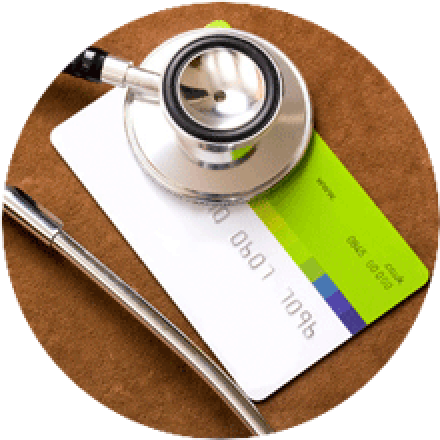Medical Credit Cards Review - Better Use a Regular Card

Medical bills have long been a primary cause of bankruptcy and debt. Many consumers look for other options to help pay for medical expenses with credit cards. Although you can essentially use any credit card to cover medical bills, there are medical credit cards specifically designed for this purpose that may provide additional benefits. Plus, even if you have health insurance, a medical credit card can cover expenses that aren’t included with your insurance such as medical devices and equipment.
These are some of the most popular options for paying your medical expenses with credit cards.
Medical Credit Cards
One of the most-used healthcare credit cards is the CareCredit card which covers a wide range of medical expenses including dental work, hearing aids, vision or cosmetic procedures, and even care for the family pet. The CareCredit Card is accepted at more than 175,000 health care providers nationwide. This card carries an APR of 26.99%, but otherwise, there are no fees. There are promotional financing offers from time to time where you can avoid paying interest if you pay your balance in full within 6 months, 12 months, or 24 months.
This credit card lets you pay for medical expenses that aren’t covered by insurance, including your pet’s veterinary expenses. You can choose deferred interest plans like 6 months for treatments of $250 or more, in which you can pay down your balance without paying interest. There are also budget payment plans for paying down balances. For example, for treatments of $1,000 or more, you can select the 24-month payment plan with an APR of 15.90%. For revolving accounts, the APR for purchases is 26.99% to 28.99%, depending on your credit worthiness.
The Wells Fargo Health Advantage Credit Card provides one of the better options for paying for healthcare expenses like dental, veterinary, vision, and audiology. For example, the APR starts as low as 12.99%, depending on your credit worthiness. It also includes special financing promotions like no interest if paid in full within 6, 12, or 18 months, and special rates of 0% APR with 12 or 36 equal monthly payments.
Prepaid Cards and Debit Cards
There are also various prepaid and debit card options which allow you to save money through healthcare providers like Humana or jobs, that you can later use to pay for medical expenses. These cards typically allow you to set up a Health Savings Account to cover medical expenses in the future. However, these aren’t the most practical solutions if you face a medical emergency and don’t have enough funds on your card to cover the expenses. For emergency situations and those where you need time to pay off the balance in smaller monthly installments, it’s best to use a card with the lowest interest rate possible. For prepaid medical cards, check with your place of employment or your health care provider.
Alternatives to Medical Credit Cards
The medical credit card options are minimal and, in many, cases, these types of cards can be expensive. If you carry a balance rather than pay in full each month, you will typically pay high amounts of interest. You can avoid interest in most cases by taking advantage of deferred payment plans and ensuring that you pay your balance off within the deferred period of time.
On the other hand, you can usually use regular credit cards for medical expenses and get better deals.
Low-Interest Credit Cards for Medical Bills
Many credit cards offer low interest rates and 0% introductory APRs for purchases when you become a new cardholder. The key to taking advantage of these rates when paying for medical expenses is to make sure you choose not just the lowest APR but an introductory APR that is long enough to pay your expenses in full. Further, unlike traditional medical bill credit cards, you can use these cards for other purchases, without worrying whether your provider is included in a qualifying network. Further, if you need to transfer a balance from one of the medical cards with higher APRs, these cards typically include promotions for saving money through 0% introductory offers. For medical expenses, these options can end up helping you save hundreds – even thousands of dollars in interest and fees.
This card offers one of the longest 0% introductory APRs for purchases available. You get 21 months to pay for medical and other purchases at 0%. After that, the variable APR starts at 13.24%, which helps if, for some reason, you can’t pay off your medical expenses within the 21-month period. There is a balance transfer fee of $5 or 3%, whichever is greater, and a foreign transaction fee of 3%, but there is no annual fee.
no annual fee
0% intro APR on purchases and balance transfers
0% BT fee for 60 days
free FICO score
The Chase Slate Credit Card is considered one of the best low-interest cards currently available. You get 0% introductory APR for purchases and balance transfers for 15 months, plus there’s no balance transfer fee within the first 60 days of account opening. After that, the balance transfer fee is $5 or 5%, whichever is greater. The APR after the introductory period starts as low as 13.24%. The foreign transaction fee is 3%, but there is no annual fee. You also get free monthly access to your FICO Score for monitoring your credit.
If you need a card for covering medical expenses, it may be best to check your bank first. The U.S. Bank Visa Platinum card offers a 0% introductory APR on purchases and balance transfers for 12 billing cycles, and then the variable APR is a low 10.24%. There is no annual fee, and the foreign transaction fee is at least 2%, depending on whether you use US Dollars or foreign currency for foreign purchases. If you need to transfer a balance, the transfer fee is 3% or $5, whichever is greater.
Make sure you check out the other cards on our list of the Best Low Interest Rate Credit Cards
Leave a comment
CREDIT SCORE UPDATES
exclusive members-only deals






